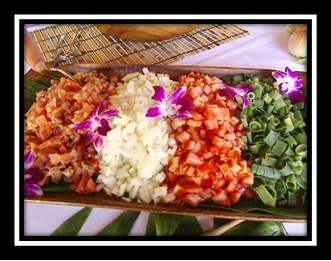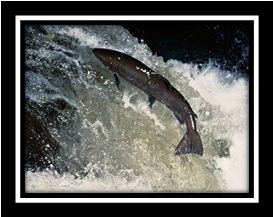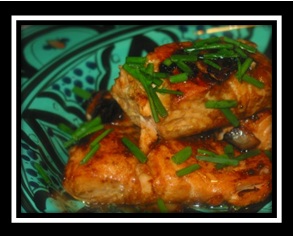Digital Collections
Celebrating the breadth and depth of Hawaiian knowledge. Amplifying Pacific voices of resiliency and hope. Recording the wisdom of past and present to help shape our future.
E Ho‘olako Mau: All Hawaiian Cook Book, Volume II. Tamar Luke Pane‘e, KS ’53.
INGREDIENTS:
1 piece salted salmon, 1 inch by 3 inches
2 thin sliced ginger, cut into slivers
1 teaspoon sugar
2 tablespoons peanut oil
1 clove garlic, crushed
DIRECTIONS:
Scale salmon and rinse with water.
Place in pan, cover with water and soak 1 hour.
Drain thoroughly and place on a small plate, preferably a cereal or fruit plate.
Sprinkle ginger on top of the salmon and steam for about 20 minutes after steamer water comes to a boil.
Remove salmon from steamer and scrape ginger to one side of the plate.
Sprinkle sugar over salmon.
Put oil into a clean frying pan and add garlic. Heat oil until it starts to smoke and garlic turns black.
Remove from heat, discard garlic and pour hot oil over sugar and fish. Replace ginger.
Fish will sizzle when oil comes in contact with water accumulated during steaming.
Serve as a side dish to accompany a meal.
About Salmon
Traditionally, salmon was always served poke (block, square) style. A relish made of kukui ʻinamona mixed with dried ʻalaʻala (octopus liver) from the heʻe and ʻalaea salt accompanied the poke kāmano (salmon) with several types of ʻakaʻakai (onion), limu kohu (a type of seaweed) and a large bowl of poi maoli (taro) or poi palaoa (flour). Early Hawaiians never ate salmon the way it is eaten today.
Around 1778, Hawaiians became crew members aboard vessels in the fur trade along the Northwest coast. They acquired a taste for salmon at once and brought it back salted to Hawaiʻi. This became a steady trade. A keg of salt-salmon was always available in well provided households, and those who could afford it got the choice alo piko (bellies). The tail portion, too hard to lomi, was cooked with greens.
The missionary families found salt salmon to be a substitute for salt cod—the New England standby. Salt-salmon, lomied with raw onion and raw tomato, as a dish for an ʻahaʻaina (known commonly today as a lūʻau, feast) became a part of the lūʻau menu in later years.

photo credit: A. Dahilig
At modern feasts, the menu is hardly complete without a dish of lomi salmon, with salmon imported from the Northwest.

photo credit: W. Andrews
According to Aunty Tamar, another name for the salmon is Kamanu, meaning bird or any winged creature. Here the salmon is depicted flying through the air upstream to spawn.

photo credit: M. Versida
Guests will enjoy the fresh taste of any salmon recipe that includes ginger!